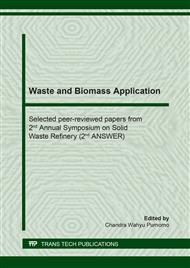p.27
p.34
p.40
p.47
p.53
p.61
p.67
p.72
p.78
A Novel Immobilization Method of Saccharomyces cerevisiae on Fermentation of Nipa Palm Sap for Fuel Grade Bioethanol Production
Abstract:
Nipa palm (Nypa fruticans) spreads abundantly in the mangrove forests of eastern coast of Sumatera Island, Indonesia. Nipa palm sap can be used as a very high-gravity (VHG) substrate for fermentation. In this research, batch fermentation of nipa sap with initial sugar content of 262.713 mg/ml using immobilized Saccharomyces cerevisiae yeast cells was studied. Immobilization of the yeasts in Na-alginate by droplet method and addition of 0.2% v/v Tween 80 and 0.5g/l ergosterol to the immobilized cells were first carried out. Then, the effect of cells weight percentage (5, 10, 15, and 20% w/v) and fermentation time (24, 36, 48, 60, 72, 84, and 96 hrs) on the bioethanol production were investigated. After, the analysis of bioethanol concentration was investigated using Gas Chromatography. The bioethanol production increased with the fermentation time until reaching a maximum value at all cell weights. Except with the 20% w/v, this peak was followed by a decrease in the bioethanol production at cell weights of 5, 10, and 15% w/v. This phenomenon may be explained by degradation of bioethanol into acetic acid resulting in the decreased concentration at the end of fermentation. The formation of acetic acid was characterized by decreases in the pH values of the fermentation medium. On the contrary, the bioethanol level tended to increase until the end of fermentation with the immobilized yeast cells of 20% w/v. High number of available immobilized yeast cells at the end of fermentation, accumulation of bioethanol produced at earlier times, and no further conversion of bioethanol to acetic acid could be the reasons for this increase. The optimum conditions for bioethanol production were 20% w/v cell weight and 96 hr fermentation time, at bioethanol concentration of 17.57% v/v.
Info:
Periodical:
Pages:
53-57
Citation:
Online since:
June 2020
Authors:
Keywords:
Price:
Сopyright:
© 2020 Trans Tech Publications Ltd. All Rights Reserved
Share:
Citation:



